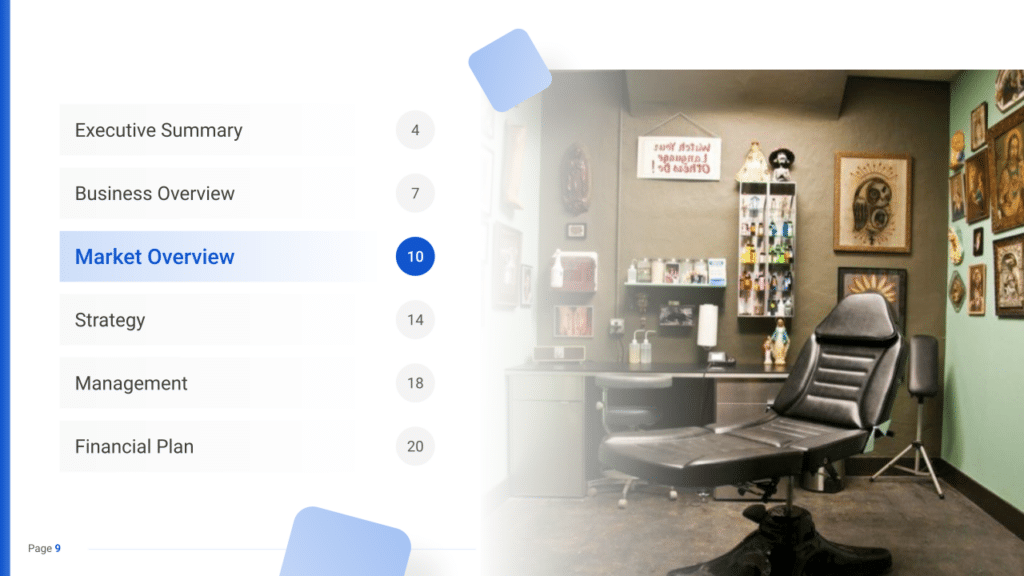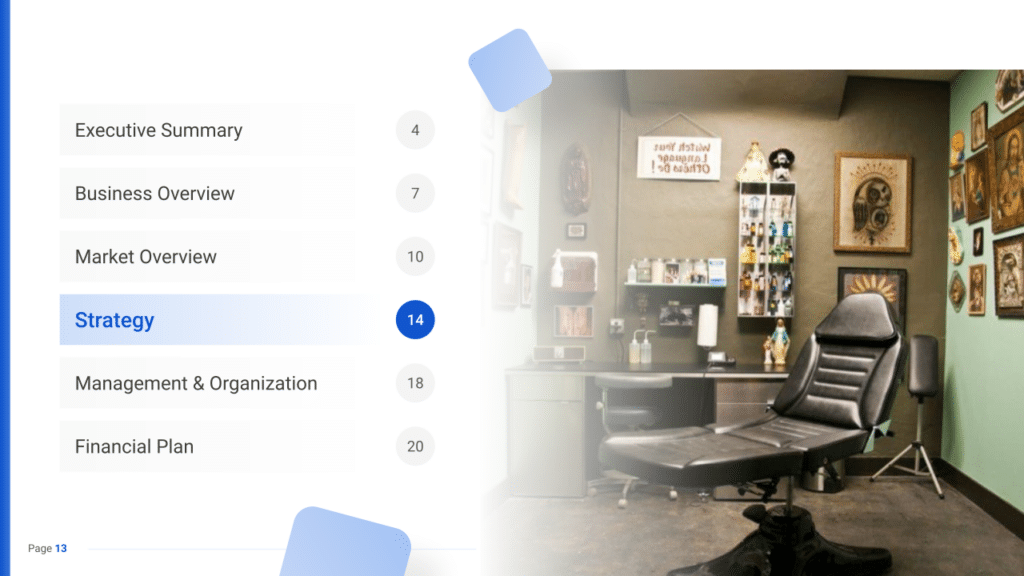Tattoo Parlor Business Plan Template & PDF Example

Creating a comprehensive business plan is crucial for launching and running a successful tattoo parlor. This plan serves as your roadmap, detailing your vision, operational strategies, and financial plan. It helps establish your tattoo parlor’s identity, navigate the competitive market, and secure funding for growth.
This article not only breaks down the critical components of a tattoo parlor business plan, but also provides an example of a business plan to help you craft your own.
Whether you’re an experienced entrepreneur or new to the beauty industry, this guide, complete with a business plan example, lays the groundwork for turning your tattoo parlor concept into reality. Let’s dive in!
The Plan
Our tattoo parlor business plan is structured to cover all essential aspects needed for a comprehensive strategy. It outlines the parlor’s operations, marketing strategy, market environment, competitors, management team, and financial forecasts.
- Executive Summary: Offers an overview of your tattoo parlor’s concept, market analysis, management, and financial strategy.
- Business Overview: Provides detailed information on your tattoo parlor and its operational model:
- Tattoo Parlor & Location: Describes the parlor’s design, atmosphere, and strategic location within a creative community, emphasizing its appeal to a diverse clientele.
- Services & Prices: Lists the variety of tattoo services offered, from custom designs to traditional, black and gray, and color tattoos, along with a clear pricing structure.
- Market Overview: Examines the tattoo industry landscape, identifying competitors and how your parlor stands out:
- Key Stats: Shares industry size, growth trends, and relevant statistics for the tattoo market.
- Key Trends: Highlights recent trends in the tattoo industry, such as the increase in custom, personalized tattoos and the importance of health and safety standards.
- Key Competitors: Analyzes main competitors in the area and differentiates your parlor in terms of artistic talent, service quality, and safety practices.
- Strategy: Outlines how the tattoo parlor plans to achieve growth and attract clients:
- SWOT: Strengths, weaknesses, opportunities, and threats analysis tailored to your tattoo parlor.
- Marketing Plan: Details strategies for promoting the parlor, including digital marketing, social media engagement, and local community involvement.
- Timeline: Key milestones and objectives from the initial setup to the first year of operations.
- Management: Information on the management team, highlighting their expertise in tattoo artistry, studio management, business operations, and customer experience.
- Financial Plan: Projects the financial performance of the tattoo parlor, including revenue targets, profit and loss statements, fundraising needs, cash flow projections, and balance sheet forecasts.

Executive Summary
The Executive Summary introduces your tattoo parlor’s business plan, offering a concise overview of your parlor and its services. It should detail your market positioning, the range of tattoo and body art services you offer, its location, size, and an outline of day-to-day operations.
This section should also explore how your tattoo parlor will integrate into the local market, including the number of direct competitors within the area, identifying who they are, along with your parlor’s unique selling points that differentiate it from these competitors.
Furthermore, you should include information about the management and co-founding team, detailing their roles and contributions to the parlor’s success. The expertise, artistic skills, and experience of your tattoo artists should also be highlighted, showcasing the talent that will attract customers. Additionally, a summary of your financial projections, including revenue and profits over the next five years, should be presented here to provide a clear picture of your parlor’s financial plan.
Tattoo Parlor Business Plan Executive Summary Example


Business Overview
The business overview segment in your executive summary is pivotal for introducing the fundamental facets of your tattoo parlor. It should encompass the establishment’s name, location, and an overview of its day-to-day operations.
Presenting a unique selling proposition (USP) delineates your tattoo parlor’s distinction amidst competitors. Whether it’s a focus on personalized designs, a specialization in specific tattoo styles, or a commitment to hygiene and safety standards, your USP is the essence of your executive summary.
Example:
“At ‘InkVerse Tattoos,’ nestled in the heart of the vibrant [City/Neighborhood], our 2,000-square-foot studio is a hub for creative expression. We offer bespoke tattoo services ranging from intricate custom designs to vivid color work. Our distinctiveness lies in our fusion of artistry and stringent hygiene protocols, ensuring an unparalleled client experience.”
Market Overview
Understanding and portraying the market landscape, encompassing size, growth trends, and industry dynamics, is crucial. This section should illuminate the scope of the tattoo industry, supported by pertinent data concerning market valuation, growth rates, and prevailing trends. It’s an opportunity to showcase your studio’s niche in this landscape.
Example:
“The US tattoo industry, valued at $1.6 billion with a consistent 2.4% CAGR from 2017 to 2022, comprises approximately 26,000 tattoo parlors nationwide. ‘InkVerse Tattoos’ identifies itself among 6 key competitors within a [x]-mile radius, capitalizing on the rising trend of personalized tattoos and prioritizing stringent health and safety measures.”
Management Team
Highlighting the expertise and backgrounds of the management team solidifies credibility. Presenting their qualifications, experiences, and contributions to the tattoo parlor’s success is paramount. This section will showcase the team’s capabilities and how their collective skills drive the business forward.
Example:
“At ‘InkVerse Tattoos,’ our founder, [Name], boasts over 15 years of professional tattoo artistry, revered for his innovation and mastery of diverse design approaches. Complementing this, our business manager, [Name], leverages years of experience in creative arts business management, focusing on client engagement and operational excellence.”
Financial Plan
Summarizing your financial objectives and projections, encompassing revenue targets and growth strategies provides a roadmap illustrating your tattoo parlor’s financial trajectory.
Example:
With a robust financial strategy, “Artful Ink Studios” sets its sights on sustainable growth and financial stability, outlining a clear revenue target of $1.0 million by 2028. Bolstered by a projected 30% profit margin (EBITDA margin), our financial projections exemplify a commitment to operational efficiency and profitability.
Business Overview
For a Tattoo Parlor, the Business Overview section can be effectively divided into 2 main slides:
Tattoo Parlor & Location
Describe the parlor’s physical environment, focusing on its unique design, artistic atmosphere, and the comfortable setting that welcomes clients. Mention the parlor’s location, emphasizing its accessibility and the convenience it offers to clients, such as proximity to cultural areas or ease of parking.
Next, discuss why this location is strategically chosen to attract your target clientele, whether it’s because of high foot traffic, nearby entertainment venues, or a culturally vibrant area that appreciates body art.
Services & Prices
Detail the range of tattoo services offered, from custom tattoo designs and traditional tattoos to contemporary styles and body piercings. Include any unique services like tattoo restoration, cover-ups, or cosmetic tattoos. Then, outline your pricing strategy, ensuring it reflects the artistry and skill involved in the services provided and aligns with the market you’re targeting.
Highlight any special offers, consultation services, aftercare packages, or loyalty programs that add value for your clients, promoting repeat business and fostering a loyal customer base.


Market Overview

Industry size & growth
In the Market Overview of your tattoo parlor business plan, begin by analyzing the size of the tattoo industry and its potential for growth, highlighting the expanding market opportunities.
Key market trends
Discuss key trends such as the rise in custom tattoo artistry, societal acceptance of tattoos, and advancements in tattoo technologies, underscoring the shift towards personalized and meaningful tattoo experiences.
Competitive Landscape
A competitive analysis is not just a tool for gauging the position of your tattoo parlor in the market and its key competitors; it’s also a fundamental component of your business plan. This analysis helps in identifying your tattoo parlor’s unique selling points, essential for differentiating your business in a competitive market.
In addition, competitive analysis is integral in laying a solid foundation for your business plan. By examining various operational aspects of your competitors, you gain valuable information that ensures your business plan is robust, informed, and tailored to succeed in the current market environment.
Identifying Your Competitors in the Tattoo Industry
Begin by mapping out local tattoo parlors and studios in your area. Direct competitors might include established tattoo studios known for their specialization in particular styles such as realism, traditional, or neo-traditional tattoos. Additionally, consider other establishments offering related services, such as body piercing or permanent makeup, as indirect competitors.
Utilize online resources like Google Maps and social media platforms to understand the geographical distribution of your competitors. Platforms like Yelp and specialized tattoo review websites provide valuable insights into customer opinions, praising aspects like artistic skill, cleanliness, and customer service at rival tattoo studios.

Tattoo Parlor Competitors’ Strategies
Analyzing your competitors involves scrutinizing various elements of their businesses:
- Artistic Offerings: Investigate the range of tattoo styles and specialties offered by rival studios. If “InkMasters” is gaining attention for their detailed black and grey realism tattoos, it signifies a demand for this style in the market.
- Artistic Techniques: Consider the tattooing techniques and styles used. A studio like “Traditional Tats” that focuses on classic tattoo styles might cater to a different clientele than one like “Futuristic Ink,” known for cutting-edge and abstract designs.
- Pricing Strategies: Compare pricing structures with your competitors. Are your rates more aligned with budget-friendly studios like “Affordable Ink” or do they resemble premium pricing akin to the services offered at “Elite Tattoos”?
- Marketing Tactics: Examine how competitors market their services. Do they leverage social media effectively, or do they rely more on partnerships with local events and influencers?
- Customer Experience: Evaluate the overall experience at rival tattoo parlors. For instance, “Serene Skin Artistry” might be known for its welcoming ambiance and personalized consultations, enhancing the customer experience.
- Operational Efficiency: Observe if competitors implement technology or innovative processes. Studios like “TechTattoo” might offer online booking systems or utilize state-of-the-art tattooing equipment, streamlining the client experience.
What’s Your Tattoo Parlor’s Value Proposition?
Reflect on your tattoo parlor’s unique offerings. Perhaps your studio is renowned for its intricate sleeve designs or specializes in a specific cultural tattoo style rarely found in your area.
Identify market gaps through client feedback and industry trends. For instance, the growing demand for eco-friendly and vegan ink might be an opportunity if competitors do not address this niche.
Consider your location: A tattoo parlor in a vibrant urban area might focus on larger, statement pieces, whereas one in a quieter neighborhood might emphasize a more intimate and personalized approach to tattooing.
Strategy

SWOT
First, conduct a SWOT analysis for the tattoo parlor, highlighting Strengths (such as highly skilled tattoo artists and a unique range of artistic styles), Weaknesses (including potential high overhead costs or intense competition in the area), Opportunities (for example, a growing acceptance and interest in tattoos as a mainstream form of self-expression), and Threats (such as shifts in social norms or regulatory changes affecting the industry).

Marketing Plan
Next, develop a marketing strategy that outlines how to attract and retain clients through targeted advertising, special introductory offers, a strong and engaging social media presence showcasing artist portfolios, and involvement in local art and cultural events. Consider partnerships with local businesses or influencers to expand your reach.
Marketing Channels
Choosing the right marketing channels to reach your audience is crucial for successful engagement.
Digital Marketing
- Social Media: Leveraging social media platforms like Instagram, TikTok, and Facebook to showcase not just your artwork but also the artistic process behind it can be powerful. Engage actively with your audience, inviting them into your world of creativity.
- Email Marketing: Building an email list can be a goldmine. Regularly sending newsletters featuring tattoo care tips, exclusive promotions, and updates about new tattoo styles or artists at your parlor can keep clients engaged and informed.
- Website and SEO: Create a professional website showcasing portfolios, client testimonials, and blogs about tattoo care and trends.
Local Advertising
- Print Media: Distribute well-designed flyers and brochures strategically in local hotspots, promoting your parlor’s unique offerings. Participate in local art events, offering consultations or sponsoring art programs to connect with potential clients.
- Community Engagement: Participate in local art fairs or exhibitions, offer free tattoo consultations, or support local events to enhance your brand’s visibility.
- Artist Collaborations: Partner with other tattoo artists or art galleries for joint art exhibitions or collaborations.
- Cross-Promotions: Collaborate with clothing brands or lifestyle stores for mutual promotions.
Promotional Activities
Attracting clients through enticing offers and loyalty programs is a proven strategy.
- Seasonal Offers: Seasonal promotions or introductory offers can encourage potential clients to take the plunge and get inked. Introduce seasonal promotions such as ‘New Year Tattoo Resolutions’ or ‘Birthday Ink Discounts’.
- Loyalty Programs: Establish a system rewarding frequent clients with discounts or additional tattoo time.
- Referral Programs: Word-of-mouth is potent in the tattoo industry. Incentivizing referrals can tap into your clients’ social circles, extending your parlor’s reach through recommendations.

Sales Channels
Effective sales strategies are crucial for revenue growth and client satisfaction:
In-Studio Upselling
- Additional Services: Suggest complementary tattoo styles or enhancements during consultations.
- Merchandise Sales: Display tattoo care products or art-related items at your studio.
- Service Bundles: Offering additional services or bundled tattoo sessions can maximize revenue per client visit. Recommending aftercare products or extended sessions can enhance the overall experience.
Online Booking and Sales
- User-Friendly Booking: Implement an intuitive online booking system offering ease and convenience to clients.
- E-commerce Integration: Sell tattoo merchandise or prints online to reach a broader audience.
Membership and Loyalty Programs
Encourage repeat business and foster long-term relationships with your clients.
- Membership Offers: Offer subscription-based memberships, including exclusive access to limited designs or discounts on multiple sessions.
- Rewards Program: Develop a digital rewards program allowing clients to collect points redeemable for discounted tattoos or art-related products.
Strategy Timeline
Finally, create a detailed timeline that outlines critical milestones for the tattoo parlor’s opening, marketing initiatives, client base growth, and potential expansion plans, ensuring the business progresses with clear direction and purpose. Additionally, include specific goals such as hosting opening events, participating in tattoo conventions, launching promotional campaigns, and evaluating customer feedback for continuous improvement.

Management
The management section focuses on the tattoo parlor’s management and their direct roles in daily operations and strategic direction. This part is crucial for understanding who is responsible for making key decisions and driving the tattoo parlor toward its financial and operational goals.
For your tattoo parlor business plan, list the core team members, their specific responsibilities, and how their expertise supports the business.


Financial Plan
The Financial Plan section is a comprehensive analysis of your financial projections for revenue, expenses, and profitability. It lays out your tattoo parlor’s approach to securing funding, managing cash flow, and achieving breakeven.
This section typically includes detailed forecasts for the first 5 years of operation, highlighting expected revenue, operating costs and capital expenditures.
For your tattoo parlor business plan, provide a snapshot of your financial statement (profit and loss, balance sheet, cash flow statement), as well as your key assumptions (e.g. number of customers and prices, expenses, etc.).
Make sure to cover here
_ Profit and Loss
_ Cash Flow Statement
_ Balance Sheet
_ Use of Funds









